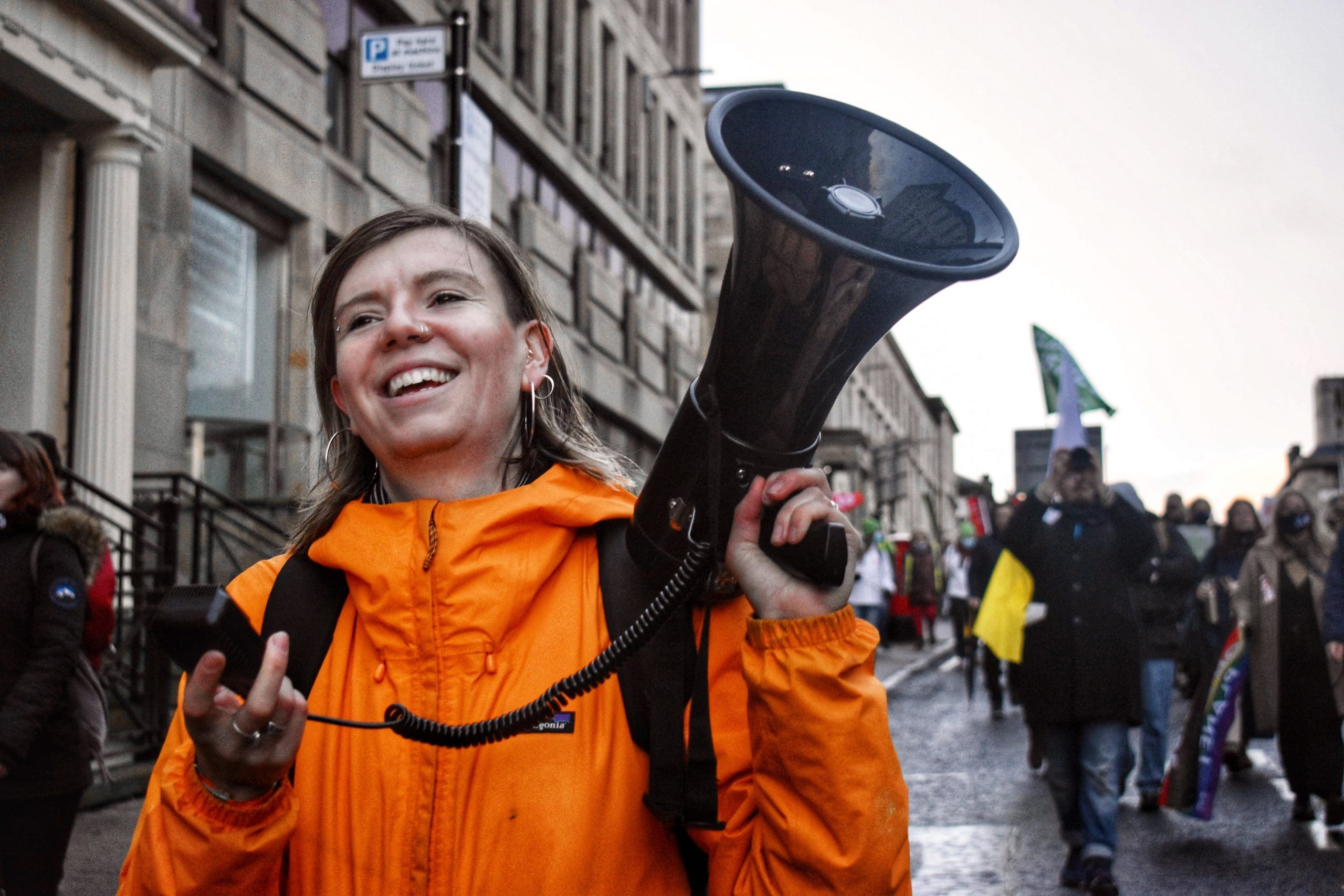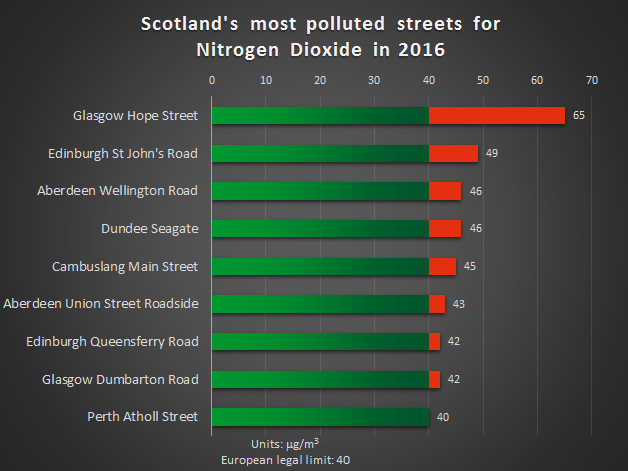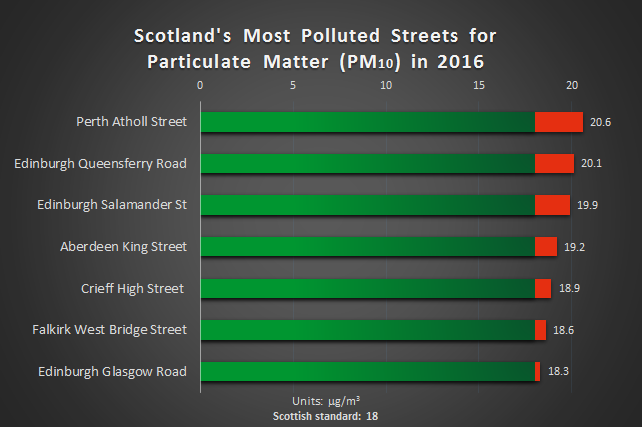
Scotland’s Most Polluted Streets Revealed – 5 New Pollution Zones Declared
Friends of the Earth Scotland today published a list of Scotland’s most polluted streets in 2016, showing that streets in many parts of Scotland continue to have unsafe and illegal levels of toxic pollution seven years after a legal deadline and despite a Government plan to comply with clean air obligations.
There are now a total of 38 Pollution Zones in Scotland where air quality safety standards are regularly broken, up from 33 last year. In 2016 new official Pollution Zones were declared in Linlithgow and Newton in West Lothian, Johnstone and Renfrew in Renfrewshire, with another new one in Edinburgh’s Salamander Street coming into force later this month.

The results of Scotland’s most polluted streets for 2016
Nitrogen Dioxide
Top 9 most polluted streets for nitrogen dioxide in 2016.
Figures in microgrammes per cubic metre (μg/m3).
- Glasgow Hope Street – 65
- Edinburgh St John’s Road – 49
- Aberdeen Wellington Road – 46
- Dundee Seagate 46
- Cambuslang Main Street – 45
- Aberdeen Union Street – 43
- Edinburgh Queensferry Road – 42
- Glasgow Dumbarton Road – 42
- Perth Atholl Street – 40
The European Ambient Air Quality Directive set a limit for NO2 of 40μg/m3, so all these sites are breaking the legal limit. The deadline for compliance was 1 January 2010.

Particulate Matter (PM10)
Top 7 most polluted streets for Particulate Matter in 2016
Figures in microgrammes per cubic metre (μg/m3).
- Perth Atholl Street – 21
- Edinburgh Queensferry Road – 20
- Edinburgh Salamander St – 20
- Aberdeen King Street – 19
- Crieff High Street – 19
- Falkirk West Bridge Street – 19
- Edinburgh Glasgow Road – 18

The Scottish air quality objective is 18 (μg/m3), so all these sites fail the objective.
The Air Quality (Scotland) Amendment Regulations 2002 required this objective to have been met by 2010.
Traffic-derived air pollution, mainly composed of fine particles and toxic gases, has been linked with cancer, allergies, asthma, strokes, heart attacks, restricted foetal development, damaged lung development in children, and more recently, the onset of dementia in adults. It causes 2500 early deaths in Scotland each year, and is second only to smoking in terms of its mortality impacts.
Friends of the Earth Scotland Air Pollution Campaigner Emilia Hanna said,
“Air pollution from traffic is a public health crisis, claiming thousands of lives each year and particularly harmful for small children, pregnant women and people living in poverty. For people living in an official Pollution Zone or near traffic-choked streets, breathing in toxic air is an inescapable fact of life. It should not be this way, we have the right to breathe clean air just as we have the right to drink clean water.
“The Scottish Government and local authorities are not tackling this public health crisis with the seriousness and urgency required. We now have a staggering 38 official pollution zones across Scotland, up from 33 last year. This means that many more people are living with illegal levels of air pollution than previously recognised. The Scottish Government has promised a “plan” for Low Emission Zones by 2018 but needs to make a public commitment that it will provide significant funding, so that local councils can get on with making serious plans to clean up the air in their area. Councils will be reluctant to introduce a Low Emission Zone unless they know there will be funding to help set them up.
“In addition to Low Emission Zones, the Scottish Government must introduce measures to cut traffic from our streets. It can achieve this by a combination of providing more safe walking and cycling paths, supporting public transport to cut congestion, and taxing or banning polluting traffic from the worst areas.
“Our addiction to cars is killing us. But it’s those who tend not to drive who are worst impacted by pollution: children, the elderly, and those living in poverty. The Scottish Government’s zeal for road building is worsening the problem. It is pouring billions of pounds into road building, which keeps the car dominating transport choices. It has to shake up its priorities if it wants to tackle the scourge of air pollution.
“Other cities have shown that pollution can be tackled. In Seville, pollution levels were cut in half via the introduction of 80km of segregated cycle routes. In London, the Mayor has promised to introduce an ultra low emission zone a year ahead of schedule as well as taxing polluting cars via a T-charge. In Paris, the Mayor has just announced plans to cut the number of polluting cars in half.”
Jean Nelson, 59, from Glasgow, has suffered from COPD (chronic obstructive pulmonary disease) for 17 years. She has to use a nebuliser roughly 4 times per day. She has been hospitalised several times in the last few years. She said:
“Cars are choking the city. A lot of people are dying unnecessarily due to air pollution. Europe has told Scotland to clean up this problem, but nothing has been done. I live at a junction where the traffic is nose to tail almost every minute of the day, and I feel like I’m choking on fumes on a daily basis.
“Air pollution makes it hard for me to breathe and on bad days, I can barely walk. I do not own a car and often have to take the bus from Hope Street. I can see black smoke coming out of the buses and sometimes am forced to take a taxi just to escape the fumes.
“We need less traffic on our roads if air pollution is going to improve. There are thousands more cars on the roads every year and the problem is only getting worse. I don’t think the City Council is listening. It should consider banning traffic from the city centre, and should crack down on vehicle idling in the city.”
ENDS
NOTES TO EDITORS
1. The league table was featured in today’s Sunday Herald: http://theherald.newspaperdirect.com/epaper/viewer.aspx
2. More regional quotes and graphics are available on request.
3. Pollution Zones, technically termed “Air Quality Management Areas” are areas, designated by local councils, where the Scottish air quality objectives are not (or are unlikely to be) being met. For a list of zones, see http://www.scottishairquality.co.uk/laqm/aqma. The newly declared zones in 2016 & 17 are:
– Salamander Street in Edinburgh: to take effect from 20 January 2017. For a map of the zone, see http://www.edinburgh.gov.uk/downloads/download/2099/salamander_street_air_quality_management_area
– Johnstone and Renfrew Town Centre in Renfrewshire, declared in September 2016: for maps, see http://www.scottishairquality.co.uk/assets/aqma-maps/Renfrewshire_Council_air_quality_review_and_assessment_Johnstone_AQMA_Order_and_map_September_2016.pdf and http://www.scottishairquality.co.uk/assets/aqma-maps/Renfrewshire_Council_air_quality_review_and_assessment_Renfrew_AQMA_Order_and_map_September_2016.pdf
– Linlinthgow and Newton in West Lothian, declared in April and July 2016 respectively. For maps, see http://www.scottishairquality.co.uk/assets/aqma-maps/AQMA_Order_for_Linlithgow.pdf and https://www.westlothian.gov.uk/media/12625/2016-Newton-AQMA-Map/large/2016-newton-AQMA-map1.jpg
4. Our analysis used data from the Automatic Monitoring Stations around Scotland which has been ratified from January 2016 – September 2016, with the October – December results to be ratified by this April. The list has been compiled based on information from the Government’s Scottish Air Quality Website (www.scottishairquality.co.uk) and we have only included data with over 75% data capture. The monitors were a combination of roadside and kerbside monitors. It should be noted that at different sites, exposure levels to the general public will be different.
Health impacts of air pollution:
– Friends of the Earth Scotland estimate that 2500 people die early each year from air pollution in Scotland alone: http://www.foe-scotland.org.uk/RCP-Report
– Air pollution, at levels seen on Scottish streets, has been linked with :
– Respiratory illness including asthma and COPD
– Heart attacks and strokes
– Low birthweight and delayed development in babies whose mothers have been exposed
– Poor lung development in children
– Dementia
– Children, the elderly, people with pre-existing health conditions, and sick are disproportionately affected by air pollution.
– (for more, see the Royal College of Physicians’ 2016 report, “Every Breath we Take: The lifelong impact of air pollution”: https://www.rcplondon.ac.uk/projects/outputs/every-breath-we-take-lifelong-impact-air-pollution)
6. Nitrogen Dioxide is poisonous gas caused by burning of fossil fuels in car engines. Exposure to NO2 is known to be linked to increased mortality and respiratory problems. Nitrogen dioxide inflames the lining of the lung and reduces immunity to lung infections such as bronchitis. https://www.londonair.org.uk/LondonAir/guide/WhatIsNO2.aspx
7. Particulate Matter are tiny, often invisible particles in the air. Particles originating from road traffic include soot from engines, small bits of metal and rubber from engine wear and braking as well as dust from road surfaces. They can penetrate the deepest part of the lungs and damage our health. The World Health Organisation advises that there is no safe level of exposure to Particulate Matter
https://www.londonair.org.uk/LondonAir/guide/WhatIsPM.aspx
8. Low Emission Zones are areas where the most polluting vehicles must stay out or pay a fine. They have been shown to reduce pollution in many European cities. London has had a LEZ since 2008 and plans to extend it.
9. It is estimated that air pollution costs the Scottish economy over £1.1 billion each year in days lost at work and costs to the NHS. (Extrapolated from a Defra assessment that air pollution costs the UK economy as a whole £16 bn per year, based on 29,000 UK- wide deaths from air pollution: Defra, “Impact pathway guidance for valuing changes in air quality” (May 2013))
10. For last year’s air pollution results, see http://www.foe-scotland.org.uk/most-polluted-streets-2015
11. Friends of the Earth Scotland is:
* Scotland’s leading environmental campaigning organisation
* An independent Scottish charity with a network of thousands of supporters and active local groups across Scotland
* Part of the largest grassroots environmental network in the world, uniting over 2 million supporters, 75 national member groups, and some 5,000 local activist groups.
